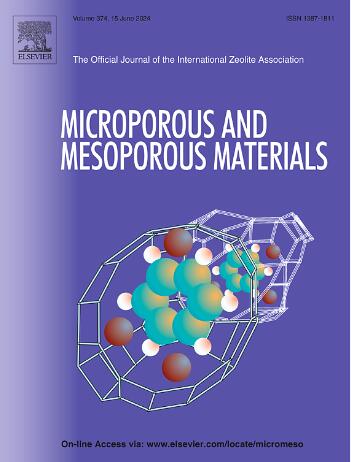Manipulating pore structures of SSZ-13 zeolite membranes via hydrocracking activation for superior H2/CO2 separation
IF 4.8
3区 材料科学
Q1 CHEMISTRY, APPLIED
引用次数: 0
Abstract
Manipulating pore structures with precisely controlled pore sizes and surface chemistry is essential for fabricating high-quality zeolite membranes. This study aims to improve the performance of SSZ-13 membranes by tuning their pore structures using an occluded organic structure-directing agent (OSDA) through low-temperature hydrocracking. The resulting membranes demonstrated notable improvements in H2/CO2 separation. Permeation tests indicated that the SSZ-13 zeolite membrane achieved a moderate H2 permeance of 1.04 × 10−7 mol Pa−1 m−2 s−1, along with a markedly improved H2/CO2 ideal selectivity of 225 at 150 °C. Both H2 and CO2 permeances increased significantly through the membrane with increasing temperatures, suggesting an activated diffusion mechanism for their permeation. The activation energy for H2 permeation was calculated to be as high as 8.98 kJ mol−1, suggesting that the membrane has a relatively small mean pore size and minimal defects. CO2 adsorption and temperature-programmed desorption (TPD) analysis showed a pronounced interaction between CO2 molecules and the SSZ-13 membrane, likely accounting for the exceptionally low CO2 permeance observed. These SSZ-13 zeolite membranes demonstrate considerable potential for efficient H2/CO2 separation in practical applications.

求助全文
约1分钟内获得全文
求助全文
来源期刊

Microporous and Mesoporous Materials
化学-材料科学:综合
CiteScore
10.70
自引率
5.80%
发文量
649
审稿时长
26 days
期刊介绍:
Microporous and Mesoporous Materials covers novel and significant aspects of porous solids classified as either microporous (pore size up to 2 nm) or mesoporous (pore size 2 to 50 nm). The porosity should have a specific impact on the material properties or application. Typical examples are zeolites and zeolite-like materials, pillared materials, clathrasils and clathrates, carbon molecular sieves, ordered mesoporous materials, organic/inorganic porous hybrid materials, or porous metal oxides. Both natural and synthetic porous materials are within the scope of the journal.
Topics which are particularly of interest include:
All aspects of natural microporous and mesoporous solids
The synthesis of crystalline or amorphous porous materials
The physico-chemical characterization of microporous and mesoporous solids, especially spectroscopic and microscopic
The modification of microporous and mesoporous solids, for example by ion exchange or solid-state reactions
All topics related to diffusion of mobile species in the pores of microporous and mesoporous materials
Adsorption (and other separation techniques) using microporous or mesoporous adsorbents
Catalysis by microporous and mesoporous materials
Host/guest interactions
Theoretical chemistry and modelling of host/guest interactions
All topics related to the application of microporous and mesoporous materials in industrial catalysis, separation technology, environmental protection, electrochemistry, membranes, sensors, optical devices, etc.
文献相关原料
公司名称
产品信息
阿拉丁
Aluminum hydroxide
阿拉丁
N, N, N-trimethyl-1-adamantylammonium hydroxide
阿拉丁
Sodium aluminate
阿拉丁
Cesium hydroxide
阿拉丁
Potassium hydroxide
阿拉丁
Sodium hydroxide
 求助内容:
求助内容: 应助结果提醒方式:
应助结果提醒方式:


